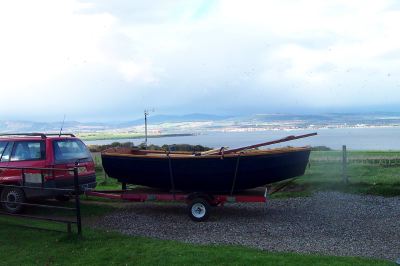Sutor Trug Sailing Dinghy (Page 1)
Making the Sutor Trug sailing dinghy R.S.King Oct 2006Dimensions and mass 1.8m x 3.55m. 93 kg

The inspiration for the Sutor came when I was given a Mirror dinghy sails and mast. The hull itself was defunct. Knowing from early youth that wilful waste makes woeful want I decided to make a hull simply and cheaply.
I based the hull on a clinker built eight foot trug I once made quickly from drawings scaled from a magazine . It had taken me forty hours and because much of that was learning time I thought a bigger one was possible on the basis of what I had learnt. A new estimate for time to build based on ratio of lengths cubed was 120 hours. It actually took 140 hours probably because of extra details such as the deck.
The Mirror dinghy is about eleven and a half feet. Multiplying all the dimensions by 1.5 matched the length but increased everything else. One other change was to make the transom upright instead of sloping as in the original.
My design was completely different to the Mirror. It was the same OAL but the scaling made it 20% wider and 15% deeper. It was to have no dagger board. A long low aspect ratio keel was made instead to keep it simple and hopefully reduce time avoiding making time consuming small detailed parts. A long keel gives directional stability which helps cruising but reduces manoeuvrability. To counter this a large efficient dagger rudder was designed to make the boat turn easily, again with simplicity in mind. Not having a lifting keel gives useful interior space and ease of going aground. The gunwale was laminated and is stiff so that the thwart is not vital for holding the shape of the hull and can be lifted out to make space, perhaps for camping.
Features are:-
Low aspect ratio keel giving low draft, directional stability and a clear interior.
Large dagger rudder for control and ease of beaching.
Wide beam and deep freeboard for stability safety and capacity.
Uninterrupted floor for maximum use of space with a useful cuddy.
Versatile sailing dinghy for family, cruising and fishing.
A curved fore-deck with support beams was introduced to stiffen the shell torsionally and vertically to support the mast. A deep transom seat was designed with the intention of stiffening the hull and providing a comfortable steering position. The decks will trap air when the boat is righted after capsize. However the large beam and freeboard should reduce the risk of capsize. There can be single person rowing or there is plenty of width for two people to take an oar each.
6mm plywood was used for the hull shell and strakes were cut-out with one straight and one curved edge. The curve was slow enough to be cut easily with a hand saw. Transoms were cut from 9mm ply and two identical pieces PVA glued to make an 18mm laminated transom. This gave a wide enough edge to fix the strakes. The transoms was set up in a simple jig the bottom panel was fastened to the transoms and the overlapping strakes were stitched together with copper wire extracted from electrical cables. Stitching the curved and straight edges together made the shape and the shell soon developed in a satisfying manner. The wedge shaped space at each strake joint was ideal for glueing with polyurethane joint filling wood adhesive so both fastening and sealing the hull. The doubling of material here acted as external stringers adding strength.
The keel was made by marking the curve of the interior bottom panel on the planed timber. After cutting the timber into two parts the concave part was fastened and glued to the outer hull and the convex part mounted on it with straight parts together. This produced a curved keel accurately fitting the exterior hull.
The transom seat support beam was made by utilising the off-cut from the top of the transom when the curve was cut. the simplest way to position it correctly was to clamp the beam to a car jack. By this means it could be moved accurately in three dimensions into position where false ends were fitted to spread load into the shell.
The transom hung rudder is on traditional hinges and features a narrow, deep, dagger rudder sliding in a box section rudder housing with the tiller on one side of the rudder housing to allow the rudder to be shipped. For simplicity, the mast shrouds can be attached by lashings through small holes, purpose made through the hull.
The design is versatile and once finished modifications can be made easily to improve the sailing qualities or use of the boat. Inverted, it can even be turned into an interesting garden shed.
Materials cost about £200.

